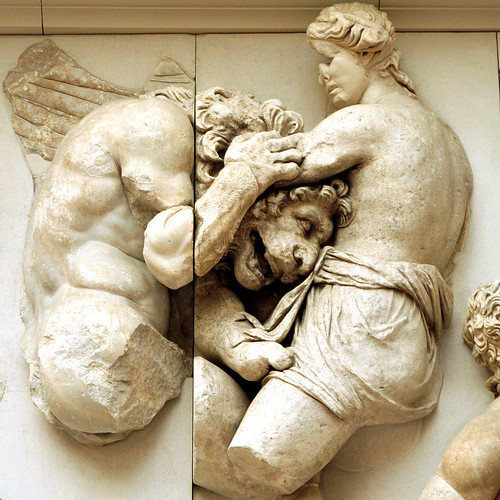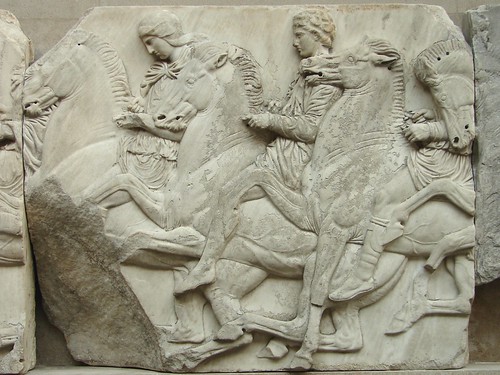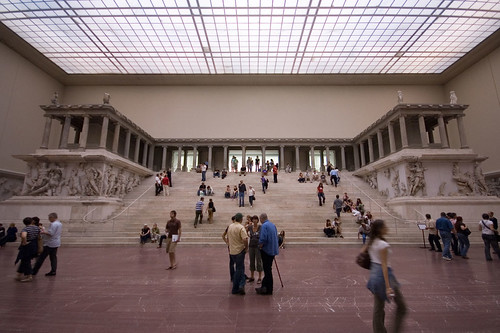 Both of these monumental pieces of sculpture are beautiful, both portray good overcoming evil and the greatness of civilised man over barbarians. The Parthenon itself is awe-inspiring. If you haven’t managed to see it yet (a perfect opportunity for a holiday in Athens!), when you get up to the Acropolis and walk around, look at the Parthenon frieze, the pediments, the metopes, and then you should get ready to pick your jaw up off the floor! It is honestly one of the most magical buildings that I have ever seen. Everything about it proclaims the glory of Athens – it’s position on the Acropolis, the monumental sculpture, and of course the story which is told by the frieze.
Both of these monumental pieces of sculpture are beautiful, both portray good overcoming evil and the greatness of civilised man over barbarians. The Parthenon itself is awe-inspiring. If you haven’t managed to see it yet (a perfect opportunity for a holiday in Athens!), when you get up to the Acropolis and walk around, look at the Parthenon frieze, the pediments, the metopes, and then you should get ready to pick your jaw up off the floor! It is honestly one of the most magical buildings that I have ever seen. Everything about it proclaims the glory of Athens – it’s position on the Acropolis, the monumental sculpture, and of course the story which is told by the frieze.
The Pergamon Altar was built during the reign of King Eumenes II in the first half of the second century BC on the acropolis in Pergamon in Asia Minor. Although it is often said to be a temple, it’s not. It is in fact more likely to be an altar for a temple, maybe for the temple of Athena which was also on the acropolis slightly abve the Pergamon altar. One of the theories is that the Pergamon altar was only a place for making sacrifices. Another is that the altar didn’t have a temple, that it was simply an altar. This sounds silly but an altar did not necessarily have to have a temple around it, although temples always had to have an altar. There is no one theory which has been widely accepted and Wolfgang Radt who had worked on the excavations at Pergamon went so far as to say: No research is undisputed concerning this most famous artistic masterpiece of Pergamon.
So Let’s compare these two great monuments head to head and see which one you think comes out on top!
The Parthenon Frieze

The Parthenon Frieze was sculpted by Phidias under the rule of Perikles during the so called ‘Golden Age’.
The frieze runs in an unbroken line around the exterior wall of the cella, and is one metre high and 160 metres long. It is carved in low relief sculpture and depicts a parade of horses, riders, gods, people and animals. All of these together are most often interpreted as showing the Panathenaic Procession.
This happened in Summer in the first month of the Athenian Calender and was an incredibly important festival for the people of Ancient Athens. It begins in the Southwest Corner and then the 2 processions go in different directions until they meet on the east side.
In the centre part of the frieze is the folding of the peplos which was woven by virgins who were dedicated to the goddess Athena. Some scholars argue that the frieze does not show a particlar Panathenaic Procession but rather that it just shows an idealised procession that indicates what the panathenaic procession should be like.
If we agree that the frieze shows the Panathenaic procession then why are there gods depicted with mortals?
The frieze is split between Athens and London, with a few stray parts housed elsewhere in the world. In London it makes up the largest part of the Elgin Marbles Collection of the British Museum.
In Athens’ New Acropolis Museum it is laid out as it would have been when it was on the Parthenon itself and the missing parts have been replaced with marble plaster casts, presumably until they manage to get the rest of the frieze back.
PLUS POINTS
- Seeing the Parthenon Frieze on the Acropolis is magical
- You get to walk around the frieze and see exactly the way it was on the Parthenon
LET-DOWNS
- The original isn’t all in one place
The Pergamon Altar

The Pergamon altar is often described as the high point of Hellenistic Art. However, little is written about its origins apart from one or two comments in the Ancient texts.
The entire altar is about 35 metres wide and 33 metres deep. It’s absolutely massive! The front stairway alone is almost 20 metres wide, and the frieze itself is about 113 metres long, one of the longest friezes from Greek Antiquity after its rival the Parthenon frieze.
The base is decorated with a frieze in high relief. This shows the battle between the giants and the gods of Olympia (Gigantomachy). Here the children of Gaia (who are often described as giant creatures with snake feet) fight against the Olympian gods.
The East frieze is the one that visitors to the Pergamon altar would have seen first and it shows most of the important Olympian gods.
There is a second, smaller frieze on the inner court walls which depicts events from the life of Telephus, who not only was the son of the great Herakles but who was also accredited as the founder of Pergamon.
The Pergamon altar is housed in Berlin. After the friezes were moved there archaeologists found that the slabs weren’t actually in the right order and so they had to be re-arranged.
Also, the old museum was found to be far too small to house the alter properly a new museum was built to display them to their best adavantage, hence how the alter got its own museum – the Pergamon Museum.
PLUS POINTS
- The altar is the high point of Hellenistic art
- The Gigantomachy is an exciting story
- It’s got its own museum
LET-DOWNS
- If you go to the site itself there’s nothing much there apart from a few olive trees
- Not all the panels survived being moved after they were found to be in the wrong order